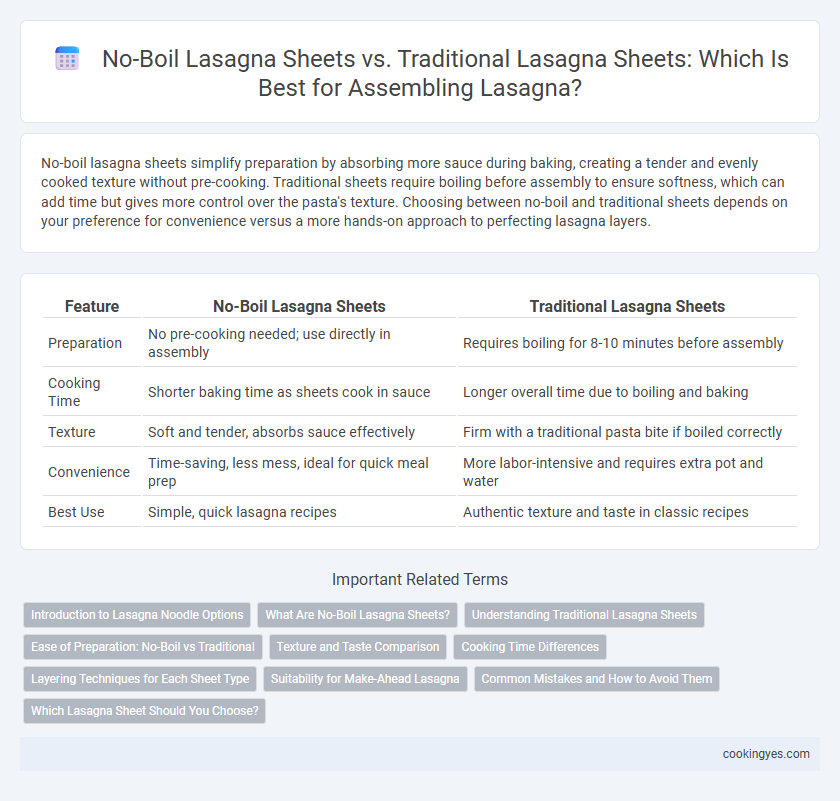No-boil lasagna sheets simplify preparation by absorbing more sauce during baking, creating a tender and evenly cooked texture without pre-cooking. Traditional sheets require boiling before assembly to ensure softness, which can add time but gives more control over the pasta's texture. Choosing between no-boil and traditional sheets depends on your preference for convenience versus a more hands-on approach to perfecting lasagna layers.
Table of Comparison
| Feature | No-Boil Lasagna Sheets | Traditional Lasagna Sheets |
|---|---|---|
| Preparation | No pre-cooking needed; use directly in assembly | Requires boiling for 8-10 minutes before assembly |
| Cooking Time | Shorter baking time as sheets cook in sauce | Longer overall time due to boiling and baking |
| Texture | Soft and tender, absorbs sauce effectively | Firm with a traditional pasta bite if boiled correctly |
| Convenience | Time-saving, less mess, ideal for quick meal prep | More labor-intensive and requires extra pot and water |
| Best Use | Simple, quick lasagna recipes | Authentic texture and taste in classic recipes |
Introduction to Lasagna Noodle Options
No-boil lasagna sheets offer a time-saving alternative by eliminating the pre-cooking step, allowing them to soften directly in the oven's moisture. Traditional lasagna sheets require boiling before assembly to ensure proper texture and even cooking within the layered dish. Choosing between no-boil and traditional sheets depends on convenience, texture preferences, and recipe specifics, influencing the final lasagna's flavor and consistency.
What Are No-Boil Lasagna Sheets?
No-boil lasagna sheets are pre-cooked pasta sheets designed to eliminate the need for boiling before assembly, saving preparation time and reducing kitchen mess. Made from semolina flour and water, these sheets absorb moisture directly from the sauce during baking, ensuring a tender texture without overcooking. Their convenience and ease of use make them a popular choice for quick lasagna recipes and efficient meal preparation.
Understanding Traditional Lasagna Sheets
Traditional lasagna sheets require pre-cooking before assembly to ensure even texture and proper layering in the dish. These sheets absorb sauce during baking, which enhances flavor but demands careful timing to avoid overcooking or sogginess. Understanding the preparation and moisture content of traditional sheets is essential for achieving the classic firm yet tender lasagna structure.
Ease of Preparation: No-Boil vs Traditional
No-boil lasagna sheets streamline preparation by eliminating the pre-cooking step, reducing total assembly time and minimizing cleanup. Traditional sheets require boiling to soften, which adds time and increases the risk of overcooking or stickiness during layering. Choosing no-boil sheets enhances convenience without compromising texture, making them ideal for quick, efficient lasagna assembly.
Texture and Taste Comparison
No-boil lasagna sheets absorb sauce and liquids during baking, resulting in a softer, more tender texture compared to traditional boiled sheets, which maintain a firmer bite. The no-boil sheets enhance the overall taste by blending seamlessly with the layers of cheese, meat, and sauce, creating a more cohesive flavor profile. Traditional sheets can sometimes create a distinguishable pasta layer that contrasts with the creamy fillings, offering a slightly chewier texture and more distinct pasta taste.
Cooking Time Differences
No-boil lasagna sheets significantly reduce cooking time by softening directly in the sauce during baking, eliminating the need for pre-cooking. Traditional lasagna sheets require boiling before assembly, adding extra preparation time and potentially affecting texture consistency. Using no-boil sheets streamlines the process, allowing for quicker meal preparation without compromising the final dish's quality.
Layering Techniques for Each Sheet Type
No-boil lasagna sheets simplify layering by allowing direct assembly without pre-cooking, ensuring even absorption of sauce and moisture during baking to prevent dryness. Traditional sheets require boiling before layering to achieve pliability and uniform texture, which demands precise timing to avoid overcooking or sticking. Effective layering with no-boil sheets involves spreading ample sauce between layers, while traditional sheets benefit from slightly drier sauces to maintain structural integrity.
Suitability for Make-Ahead Lasagna
No-boil lasagna sheets are ideal for make-ahead preparations due to their ability to soften during baking, eliminating the need for pre-cooking and saving time in assembly. Traditional lasagna sheets require boiling before layering, which can extend prep time and complicate advance assembly. For meal prepping and storing assembled lasagna before baking, no-boil sheets offer superior convenience and texture consistency.
Common Mistakes and How to Avoid Them
Common mistakes with no-boil lasagna sheets include insufficient sauce coverage, which prevents proper hydration and leads to uneven cooking. Traditional sheets often cause overcooking or sogginess if boiled too long before layering, altering texture and flavor. To avoid these issues, ensure generous, evenly spread sauce for no-boil sheets and cook traditional sheets al dente, allowing perfect absorption during baking.
Which Lasagna Sheet Should You Choose?
No-boil lasagna sheets save time by softening during baking, reducing prep steps and ensuring even texture throughout the dish. Traditional sheets require pre-cooking to avoid dryness but offer more control over doneness and texture customization. Choosing between no-boil and traditional pasta depends on your preference for convenience versus precise cooking control in lasagna assembly.
No-Boil Sheets vs Traditional Sheets for Lasagna Assembly Infographic

 cookingyes.com
cookingyes.com